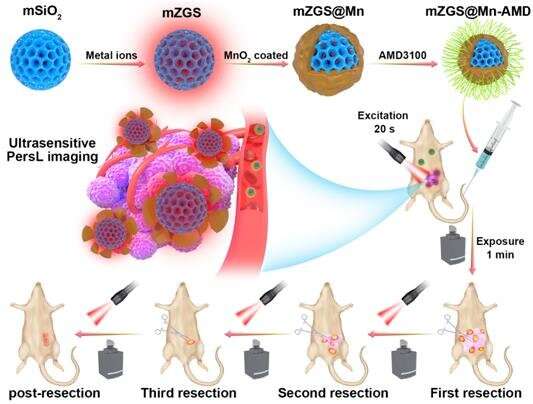This article has been reviewed according to Science X's editorial process and policies. Editors have highlighted the following attributes while ensuring the content's credibility:
fact-checked
peer-reviewed publication
trusted source
proofread
Near-infrared persistent luminescence nanoprobe developed for ultrasensitive image-guided tumor resection

Medical imaging technology such as magnetic resonance imaging (MRI), computed tomography (CT) and X-ray cannot provide real-time images during tumor resection surgery, and surgeons usually rely on visual cues, touch and experience to distinguish tumor margins, leading to a high probability of tumor residues.
Compared with traditional medical imaging, near-infrared (NIR) fluorescence imaging has the advantages of real-time use, high sensitivity, high resolution and no radiation. However, for tiny tumor residues, it requires a relatively high sensitivity.
In a study published in Advanced Science, the research group led by Prof. Zhang Yun from Fujian Institute of Research on the Structure of Matter of the Chinese Academy of Sciences has developed a novel ultrasensitive nanoprobe (mZGS@Mn-AMD) with ultrahigh tumor/normal tissue (T/NT) signal ratio to distinguish residual tumor tissues from normal tissues.
Persistent luminescent nano core (mZGS) has a high sensitivity because it does not need continuous excitation, and there is no background fluorescence interference generated by biological tissues during imaging.
The researchers quenched persistent luminescence (PersL) in normal tissue by the outer layer of MnO2, and recovered it due to the degradation of MnO2 in tumor microenvironments, improving the sensitivity of tumor imaging.
In an orthotopic breast cancer model, the intraoperative tumor-to-normal tissue (T/NT) signal ratio of the nanoprobe was 58.8, about nine times that of down-conversion nanoparticles. The T/NT ratio of residual tumor (< 2 mm) remained 12.4, considerably high to distinguish tumor tissue from normal tissue.
In addition, multiple-microtumor, 4T1 liver-implanted tumor and lung metastasis models were built to prove that this ultrasensitive nanoprobe can recognize tumor residues.
This study introduces an ultrasensitive and convenient imaging technique for recognizing residual tumor tissue, paving the way for complete surgical removal.
More information: Peng Lin et al, Near‐Infrared Persistent Luminescence Nanoprobe for Ultrasensitive Image‐Guided Tumor Resection, Advanced Science (2023). DOI: 10.1002/advs.202207486
Journal information: Advanced Science
Provided by Chinese Academy of Sciences





















